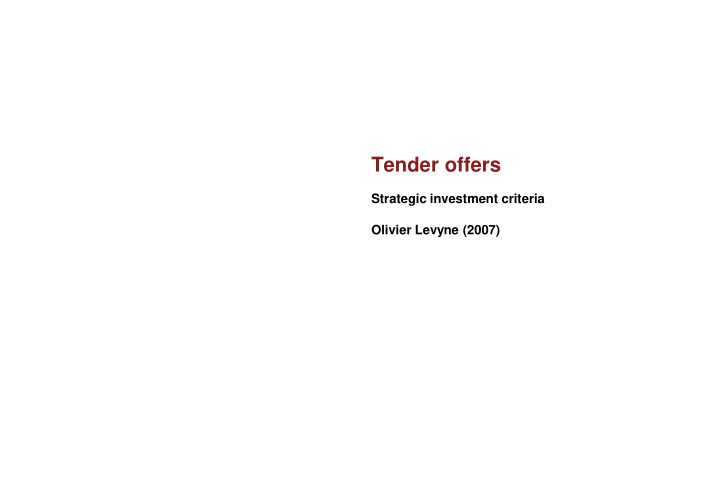



Tender offers Strategic investment criteria Olivier Levyne (2007) Global Investment Banking
1. Introduction to strategic investment decisions The NPV is one of the drivers of the decision as the valuation of the target generally relies on the Discounted Cash Flows approach But the investment decision relies on other criteria: It must be EPS accretive in order to create shareholders value It must be acceptable from a banking point of view These criteria enable to define the modality of the transaction: Cash offer Share offer Mix offer Beyond industrial considerations, the decision is eventually based on a sensitivity analysis
2. Purchaser ’s EPS accretion / dilution in a cash offer PER = Price/EPS. ie: Price = PER x EPS . Hence, if the PER is stable (no change in the market status of the share): D. Price = PER x D .EPS Taking into account that, under IRFS, the goodwill is no more amortized: Share of the target’s net profit (Post tax interest expenses) ______________________ Impact of the acquisition on the acquirer's net profit= D RN A Accretive cash tender offer if, for a 100% acquisition of the target’s capital: NP T > i.V where: NP T = target’s net profit i = post tax cost of debt [ie: pretax cost of debt x (1 – corporate tax rate)] V = target value (ie: market cap. + premium) Then: V/NP T < 1/i =Cash PER Hence: Accretive Cash tender if: Target PER < Cash PER EPS accretion= (EPS after – EPS before) / EPS before The number of the acquirer’s shares is unchanged. Then, with NP A = acquirer’s net profit EPS accretion= ( NP A after – NP A before) / NP A before= D NP A / NP A before
3. Purchaser ’s EPS accretion / dilution in a share offer NP A : Net profit of the acquirer (A) A share tender offer consists in proposing to NP B : Net profit of the target (B) n A : Number of A shares before the tender offer target’s the shareholders to swap their n B : Number of B shares bidder’s (listed) shares for the listed C A : Price per A share securities. C B : Price per B share These securities generally correspond to new shares The share offer is accretive if : EPS A after the transaction > EPS A before the transaction issued by the bidder + NP NP NP A B A > C The exchange parity generally includes a n + B n ( . n ) A A B C 20%-30% premium on the target share price A + NP NP NP A B A > The goodwill corresponds to the difference + n C n C n A A B B A between: C A + NP NP NP the valuation of the target (ie the number of shares A B A > + n c n c n C issued by the bidder x the last price of the bidder A A B B A A share) (NP A + NP B ) n A C A > NP A (n A C A + n B C B ) the equity group share of the target x % purchased (ie 100% if the bidder had no interest in the target’s n A C A NP B > n B C B NP A capital before the tender offer) n C n C A A B B > NP NP A B C C A B > NP NP A B n n A B C C A B > ie PER A > PER B EPS EPS A B
4. Banks’ constraints / main covenants Gearing: Net debt / Equity <1 Debt coverage: Net debt / EBITDA < 3 Interest coverage: EBIT / net financial expenses > 4
Recommend
More recommend